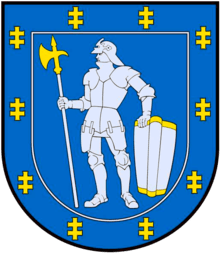Pollaxe
The pollaxe (also poleaxe, pole-axe, pole axe, polax, and Hache (French meaning axe)) is a European polearm that was widely used by medieval infantry.

Etymology
Weapons such as the halberd, bardiche, and Danish axe are sometimes mistakenly called pollaxes as they are indeed axes mounted on poles, but many etymological authorities consider the poll- prefix historically unrelated to "pole", instead meaning "head".[1][2]
However, some etymologists, including Eric Partridge, believe that the word is derived from "pole".[3]
Types of pollaxe
.jpg)
The pollaxe design arose from the need to breach the plate armour of men at arms during the 14th and 15th centuries. Generally, the form consisted of a wooden haft some 1.2–2.0 m (4–6.5 ft) long, mounted with a steel head. It seems most schools of combat suggested a haft length comparable to the height of the wielder, but in some cases hafts appear to have been created up to 2.4 m (8 ft) in length.
The design of the head varied greatly with a variety of interchangeable parts and rivets. Generally, the head bore an axe or hammer upon the damaging 'face', with a spike, hammer, or fluke on the reverse. In addition, there was a projection from the top (often square in cross section) built somewhat like a dagger. The head was attached to the squared-off wooden pole by long flat strips of metal, called langets, which were riveted in place on either two or four of its sides. Also, a round hilt-like disc called a rondelle was placed just below the head. They also appear to have borne one or two rings along the pole's length as places to prevent hands from slipping. Also of note is that the butt end of the staff, opposite the weapon's head, bore a spike.
On quick glance, the pollaxe is often confused with the similar-looking halberd. However, the axe blade on a pollaxe seems to have been consistently smaller than that of a halberd. A smaller head concentrates the kinetic energy of the blow on a smaller area, enabling the impact to defeat armour, while broader halberd heads are better against opponents with less armour. Furthermore, many halberds had their heads forged as a single piece, while the pollaxe was typically modular in design.[4]
Fighting with pollaxe
The pollaxe was usually used by knights and other men-at-arms while fighting on foot. The pollaxe has a sophisticated fighting technique, which is based on quarterstaff fighting. The blade of the pollaxe can be used, not only for simply hacking down the opponent, but also for tripping him, disarming him and blocking his blows. Both the head spike and butt spike can be used for thrusting attacks. The haft itself is also a central part of the weapon, able to block the enemy's blows (the langets helping to reinforce the shaft) as well as for "cross-checking" and tripping.
Many treatises on pollaxe fighting survive from the 15th and 16th centuries. Pollaxe fighting techniques have been rediscovered with the increasing interest in historical European martial arts.
Today the pollaxe is a weapon of choice of many medieval re-enactors. Rubber pollaxe heads designed for safe combat are available commercially.
Popular usage
The poleaxe, in that spelling, refers to an animal-culling device of similar appearance. It was swung so the spike struck the animal, normally cattle, in the forehead, hence also the expression 'to be poleaxed' referring to being stunned. This term does not appear before the 19th century.
See also
References
- The Oxford English Dictionary gives the following etymology, s.v. Poleaxe:
- [ME. pollax, polax, Sc. powax = MDu. polaex, pollaex, MLG. and LG. polexe, pollexe (whence MSw. 15th c. polyxe, pulyxe, MDa. polöxe), f. pol, POLL n.1, Sc. pow, MDu., MLG. polle, pol head + AXE: cf. MDu. polhamer = poll-hammer, also a weapon of war. It does not appear whether the combination denoted an axe with a special kind of head, or one for cutting off or splitting the head of an enemy. In the 16th c. the word began to be written by some pole-axe (which after 1625 became the usual spelling), as if an axe upon a pole or long handle. This may have been connected with the rise of sense 2. Similarly, mod.Sw. pålyxa and Westphalian dial. pålexe have their first element = pole. Sense 3 may be a substitute for the earlier bole-axe, which was applied to a butcher's axe.]
- Wise, Terence; Embleton, G.A. (1983). The Wars of the Roses. Men at Arms. 145. Osprey. p. 33. ISBN 0-85045-520-0.
- For instance, Partridge gives the following etymology:
- L Palus, stake becomes OE pal, whence ME pol, pole, E Pole, the ME cpd pollax, polax becomes poleaxe, AE poleaxe: cf AX (E)
- The Poleaxe
Further reading
- Schulze, André (Hrsg.): Mittelalterliche Kampfesweisen. Band 2: Kriegshammer, Schild und Kolben. - Mainz am Rhein. : Zabern, 2007. - ISBN 3-8053-3736-1
External links
| Wikimedia Commons has media related to Pollaxes. |
- Le Jeu de la Hache
- Spotlight: The Medieval Poleaxe (myArmoury.com article)